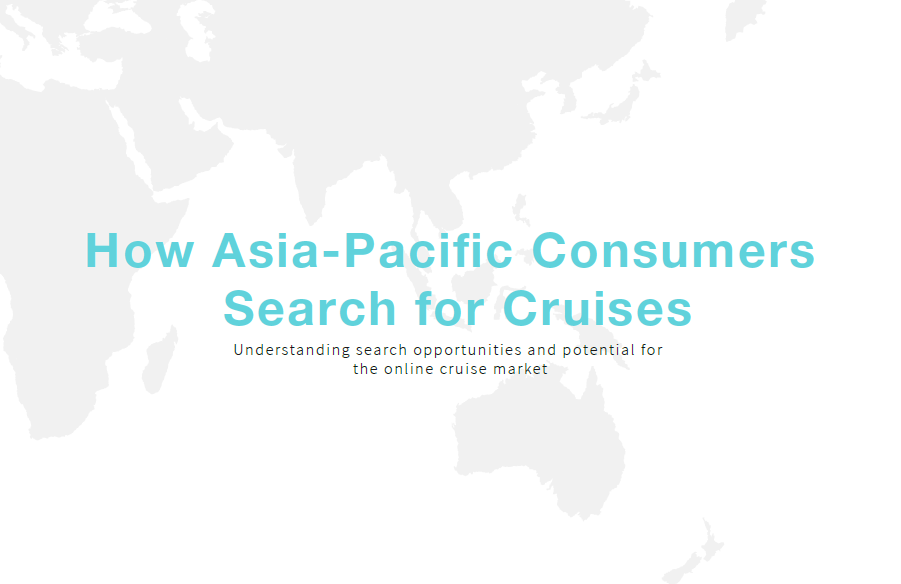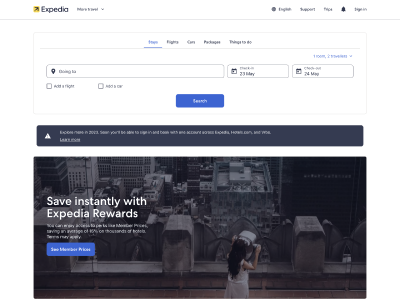APAC Cruise SEO
The information in this post is dated from 2015. To get the latest insights into How Asia-Pacific Consumers Search for Cruises online in 2017-2018, download our latest whitepaper on APAC Cruise SEO.
 Table of Contents
Table of Contents
- Introduction
- Methodology
- Summary
- Trends in the Online Cruise Market
- Niche Markets
- King of Competition
- Who Gets the Most Links?
- Demographics
- Linguistics
- Devices
- Launching Your Campaign
 Introduction
Introduction
With a steady incline in the searches for cruise throughout the Asia-Pacific, we thought it would be interesting to explore the online cruise market and gain key insights into the industry. We took a close look at some of the major trends in the online cruise space.
We’ve delved into global events and analysed their impact on the market, we took a look at the year on year trends and the ‘cruise’ search forecast throughout the Asia-Pacific.
We determined what Asia-Pacific consumers are searching for within the confines of the cruise industry and took a look at demographics and linguistics for you to better understand your target audience.
We also took a close look at the niche markets within the cruise industry and analysed the big brand names in the space, so that you can get a feel for your competitors, learn from them and ultimately outperform them.
We inspected peoples preferred devices and explored seasonality trends, identifying the best possible time for you to plan and launch that next campaign.
 Methodology
Methodology
Keyword, trend, demographic and competitor data has been collected using a combination of sources and that information has been thoroughly analysed to identify key categories and insights into the online cruise space.
Key events, seasonality and platform trends were analysed to identify patterns and gain insight into the industry. Analysis of the keyword data set was used to develop a linguistic report of the market and to further understand the language Asia-Pacific consumer’s use when they search.
Search volumes were analysed to discover and explore the key categories within the cruise industry and develop a better understanding of niche markets within the sector. Competitors were ranked by their performance in natural search for the online cruise market as a whole.
Data was recorded in May 2015 and gives analysis of information from months to years prior, indicated within each segment of the paper. Natural search rankings were recorded in May 2015 and may have changed by the time this report is published.
Download our latest report on How Asia-Pacific Consumers Search for Cruises – APAC Cruise SEO, to get current data and information.
 Summary
Summary
- The Asia-Pacific market is heavily dominated by generic cruise search terms, meaning consumers are unaware of unsure of the more niche markets.
- Asia-Pacific consumers are most often searching for domestic cruises.
- There are a number of specific cruise niches, the most popular being ‘river cruise’, which presents a space for smaller brands to enter the market.
- More than a half of all ‘cruise’ searches are being conducted on desktop computers as opposed to mobile and tablet devices.
- Searches for ‘cruise’ have been steadily increasing over the past 3 years, after a drop in the market in 2011-2012.
- The most popular finance-related search term is ‘deals’. Aside from generic travel insurance, Asia-Pacific consumers are most often searching to find cheaper cruises.
 Snapshot of the APAC Cruise Industry
Snapshot of the APAC Cruise Industry
According to the latest data from Cruise Market Watch, 12.8% of cruise passengers world-wide are from the Asia-Pacific (8.5% Asia, 4.3% Australia and New Zealand).
The Asia-Pacific accounts for 10% of global capacity, with 13.5 million bed days, according to Cruise Lines International Asociation (CLIA) and G. P. Wild International Limited.
Asia
- According to the Cruie Lines International Association (CLIA) in 2015, 52 ships will provide 1,065 Asian cruises with capacity for 2.17 million passengers.
- According to the recent Asia Cruise Trends Study conducted by the CLIA, Asia is experiencing robust double-digit growth of cruise ships, passengers and ports in the region.
Australia
- Roy Morgan Research shows that the number of Australians taking cruise holidays has grown by almost 41% since 2011.
- Australia’s industry has grown 130% since 2009 according to Cruise Lines International data.
- CLIA anticipates that the Australian cruise industry will hit the one million passengers per annum mark by 2016.
 Year on Year Trends
Year on Year Trends
If we take a look at the below chat, we can clearly see how APAC searches for ‘cruise’ relating to travel have gradually increased since the 2011-2012 drop and are expected to continue to increase in 2016.
 Global Events
Global Events
We know that traditionally, cruise lines have planned 2-3 years in advance and published itineraries 18 months to 2 years in advance. Certain incidents, however, have prompted the industry to reconsider, reviewing their planned deployments and sometimes even moving ships to regions less impacted by particular circumstances.
For example, when cruise lines became aware that the Australian economy had not gone into recession following the global financial crisis, unlike many of America’s source markets, several ships were moved to the country on a full year or seasonal basis.
The global cruise industry is particularly susceptible to a range of external factors such as the economy, climate and security, so we thought it would be interesting to take a look at a couple of global events, both positive and negative and see what kind of impact they had on search volumes within the cruise market.
Costa Concordia Disaster
As you can clearly see from the chart below, searches for ‘cruise’ relating to travel drop dramatically from January to March 2012, following the Costa Concordia disaster. Some of this drop can be attributed to seasonal trends in the market, however, this great a drop cannot be accounted for by seasonal trends alone.
Chinese Economy Grows 10.7% in 2006
The Chinese economy has also clearly impacted searches for ‘cruise’ relating to travel in China. As the Chinese economy grows so too do searches for ‘cruise’ by Chinese consumers.
 Top Destinations
Top Destinations
While most Asia-Pacific cruisers are searching for generic cruises, many are also searching for cruises for a specific geographical location. By understanding which areas Asia-Pacific consumers are most interested in, you are better able to target your product offerings, marketing campaigns and website optimisation.
According to the Asia Cruise Trends study by the CLIA, Asian cruisers are primarily exploring Asian destinations, more than 9 out of 10 Asian passengers cruised within Asia, while the remaining 9% flew to cruise destinations outside the region, primarily in Europe, followed by Alaska and the Caribbean.
According to the Global Cruise Impact Analysis 2013, conducted by the CLIA and G. P. Wild International, a total 1.23 million passengers embarked on cruises at Australian ports, Sydney accounting for 82%.
In 2013 there were 802 Asia to Asia cruises, in 2015 this is expected to grow to 981 – Asia Cruise Trends Study, CLIA.
Days deployed in East Asia are growing 20.5% annually and in South East Asia 10% while deployment in South Asian destinations which accounts for just 6% of the total is growing at 34% per annum.
 Top 20 Most Searched for Destinations for Asia-Pacific Cruisers
Top 20 Most Searched for Destinations for Asia-Pacific Cruisers
Numbers represent the average keyword search volume in a month within the Asia-Pacific.
- Sydney 31,300
- Australia 26,310
- Singapore 17,650
- Brisbane 12,810
- Caribbean 9,510
- Mediterranean 6,280
- Whitsundays 5,880
- Melbourne 5,680
- Oceania 4,840
- Europe 4,750
- New Zealand 4,220
- Halong Bay 2,960
- Pacific 2,900
- Hawaii 2,500
- Gordon River 1,900
- Alaska 1,780
- Milford Sound 1,600
- Greek Islands 1,600
- Murray River 1,600
- Fiji 1,400
 Niche Markets
Niche Markets
Segmenting the market is important in order to understand and better target and serve potential customers. We have categorised the top niche markets in the Asia-Pacific cruise search space.
Numbers represent the average keyword search volume in a month within the Asia-Pacific.
- Cruise 31,600
- River 25,420
- Harbour 7,210
- Dinner 3,700
- Dolphin 2,050
- Short 1,880
- Gay 1,630
- Repositioning 1,430
- Christmas 930
- Singles 900
- Family 690
- New Years Eve 600
- Lunch 470
- Comedy 420
- Luxury 320
Top 15 Niche Markets
The chart displays the relative popularity of each market within the cruise travel space. Generic ‘cruise’ searches make up approximately 40% of searches by Asia-Pacific consumers within the sector and generic ‘river cruise’ searches in second place, with approximately 32% of the market. Therefore more specific niche markets make up the extra 28% of the online cruise space.
This clearly shows that the vast majority of Asia-Pacific consumers aren’t sure exactly what type of cruise they are looking for and/or they don’t know what types of cruises are available. This implies that there is great opportunity within the cruise market to educate consumers on what type of cruises are available to them.
According to the CLIA specialty cruises are thriving, with luxury yachts and elegant ocean liners, plus the newest river cruises experiencing double digit passenger growth.
Specialty cruises have grown by 21% annually from 2009 to 2014.
In Australia, river cruising grew by 25% from 2012-2013.
Almost 30% of P&O Cruises passengers are families, 45% couples and over 20% friends. – P&O Cruises Australia.
The CLIA also notes a growing family market with 25% of passengers under the age of 40.
 King of Competition
King of Competition
Determining where you’re placed in the Asia-Pacific market and knowing who your competition is, is important in order to compete, optimise your website and grow your customer base.
By knowing and understanding your competition you can learn from them, observe their tactics and ultimately, outgrow them.
The numbers below show the Asia-Pacific monthly search volumes for branded cruise search terms. Interestingly, Australian brands feature heavily in the list, further indicating a trend towards domestic cruises.
- Princess 102,500
- P&O 93,200
- Carnival 75,500
- Celebrity 31,600
- Captain Cook 11,600
- Star Cruises 10,200
- Cruise Sale Finder 9,900
- Norwegian Cruise Line 9,800
- MSC 8,100
- Royal Caribbean 8,100
- Just Cruises 4,400
- Cruise 1st 4,400
- Ozcruising 4,400
- Cruise Finder 4,400
- Cruise Guru 3,600
- Disney 3,600
- APT 3,200
- Cruise About 2,900
- Crystal Cruises 2,400
- Silversea Cruises 2,400
Carnival Corporation has it’s sights set on Asia, dedicating significant proportions of recent earnings calls to the potential markets and millions of Chinese consumers – Cruise Industry News 2014-2015 State of the Industry Annual Report.
According to the same report, in Australia P&O Cruises maintains it’s market share but has introduced more Asia-Pacific themed sailings to places such as Papua New Guinea, following the entrance of a year-round Carnival Cruise Lines ship and a second seasonal Carnival ship.
Carnival are extremely active online, especially search marketing on Google. Although there’s been a big shift in how companies compete since the decision in 2013 by Carnival to enforce its Google copyright and prevent travel agencies from bidding on it’s brand terms.
Carnival Australia has the majority of cruising business in the Australian market, Royal Caribbean has a smaller presence in Australia but in 2012 expressed its intention that: “In 2013 we will continue to focus on the development of key markets in Asia and focus on sourcing guests and adding capacity to other markets where we expect significant growth and profitability” – CLIA.
 Who Gets the Most Links?
Who Gets the Most Links?
 Demographics
Demographics
Obviously, understanding the demographics of your potential customer’s is important to better target your market, online messages and content.
According to the latest 2015 data from Cruise Market Watch, approximately 66% of Asia-Pacific cruisers are from Asia while approximately 34% are from Australia and New Zealand.
Today’s global average cruiser is 49 years old, married, employed full-time, college educated and has an income of $114,000. – 2015 Cruise Industry Outlook, CLIA
Short or Long Term Stays?
The pie char below represents the number of searches by Asia-Pacific consumers related to long and short-term cruises, with just under 2,000 searches per month made relating to short-term cruises and almost 1,500 relating to longer-term world and repositioning cruises.
According to Roy Morgan research, Australian Cruisers who took a long cruise (3 or more nights) reported spending an average of 21 nights away.
As many Asian guests have limited vacation entitlements, there are more short duration cruises being selected by Asian consumers, with 48% of Asian passengers choosing cruises lasting 2-3 nights and just 12% opting for 7-13 nights cruises. – Asia Cruise Trends Study, CLIA
Australian cruise lengths are getting longer, with 8-14 day cruises surging in popularity, accounting for 57% of cruises taken in 2013. – CLIA
Cruise lines are offering more short term cruises with Carnival Cruises launching 133 cruises for 2016-2017 with an increase in short breaks at sea, including 7 weekend getaways. – Travel Weekly interview with Carnival Cruise Line Vice President Australia, Jennifer Vandekreeke
Age
According to data on Asia-Pacific searchers searching for ‘cruise’, 22% are 25-34, however this age group does not represent the biggest Asia-Pacific cruisers, indicating that while older age groups may be taking more cruises, those searching the internet for cruise products are much younger.
This means that while a specific cruise lines greatest market may be cruisers aged over 40, there may be benefit in tailoring their website to appeal to a younger audience.
According to Roy Morgan research, 71.1% of Australian cruisers are aged 50 or over.
China’s generation Y (aged below 35) made up most of the country’s outbound travel, this trend is echoed in the cruise industry. In four of the largest cruise markets: China, Malaysia, Indonesia and Philippines, more than 4 out of 10 passengers were under 40. – World Tourism Cities Federation
The average age of a P&O cruiser is 42, with 31% of passengers aged 0-29, 49% aged 30-59 and 20% over 60. – P&O Cruises
Gender
According to data on Asia-Pacific searchers, 48% of searches for ‘cruise’ are conducted by men, while just 32% are searched by females. 19% is unknown.
 Linguistics
Linguistics
Creating a better understanding of the language and phrasing Asia-Pacific consumer’s use when searching for cruises is essential when wanting to rank highly in search results.
By matching the language, keywords and phrasing on your site with the language Asia-Pacific consumer’s use when searching, you are far more likely to rank well for those same queries.
Asia-Pacific Cruisers are looking for a good deal. The numbers below look at the top 10 phrases Asia-Pacific Cruisers use when searching for the best price for cruises.
- Deals 28,360
- Cheap 9,370
- Sale 1,590
- Specials 880
- Promotion 800
- Offers 720
- Discount 720
- Sales 590
- Cheapest 260
- 2 for 1 210
Below we can clearly see the most used keywords within searches for cruise. The cloud map shows the most common keywords used in search terms by Asia-Pacific consumers looking for cruises. The larger the word, the more often it is used. The word ‘cruise’ has been omitted for the purpose of this map.
 Devices
Devices
Mobile search is now a huge player in the online space but how relevant is it to the Asia-Pacific cruise market?
While mobile search is certainly growing, ‘cruise’ searches by Asia-Pacific consumers are still primarily made via desktop, with a total average of just 37% of searches for ‘cruise’ conducted on mobile devices over the last 12 months.
 Launching Your Campaign
Launching Your Campaign
APAC Seasonal Trends
Understanding seasonal trends in the online cruise space can help you better plan activity and prepare you for launching your next campaign.
Knowing when your target audience is making travel arrangements and searching for ‘cruise’ helps you to plan and push your campaigns and content and online and offline messaging.
We determined the seasonal trends using search volume data for the keyword ‘cruise’ relating to travel across the Asia-Pacific. The seasonal activity that has been calculated by the average number of monthly searches over the past 10 years.
We chose the 3 largest countries in the Asia-Pacific, each from South Asia, East Asia and the Pacific to distinguish the differences in seasonal trends throughout the Asia-Pacific.
China’s Seasonal Trends
India’s Seasonal Trends
Australia’s Seasonal Trends
 How Asia-Pacific Consumers Search for Cruises
How Asia-Pacific Consumers Search for Cruises
Download our latest research into the cruise industry in the Asia-Pacific and get the most up to date information on how Asia-Pacific consumers search for cruises online in 2018.
Our current whitepaper is full of APAC cruise SEO and SEM research




























